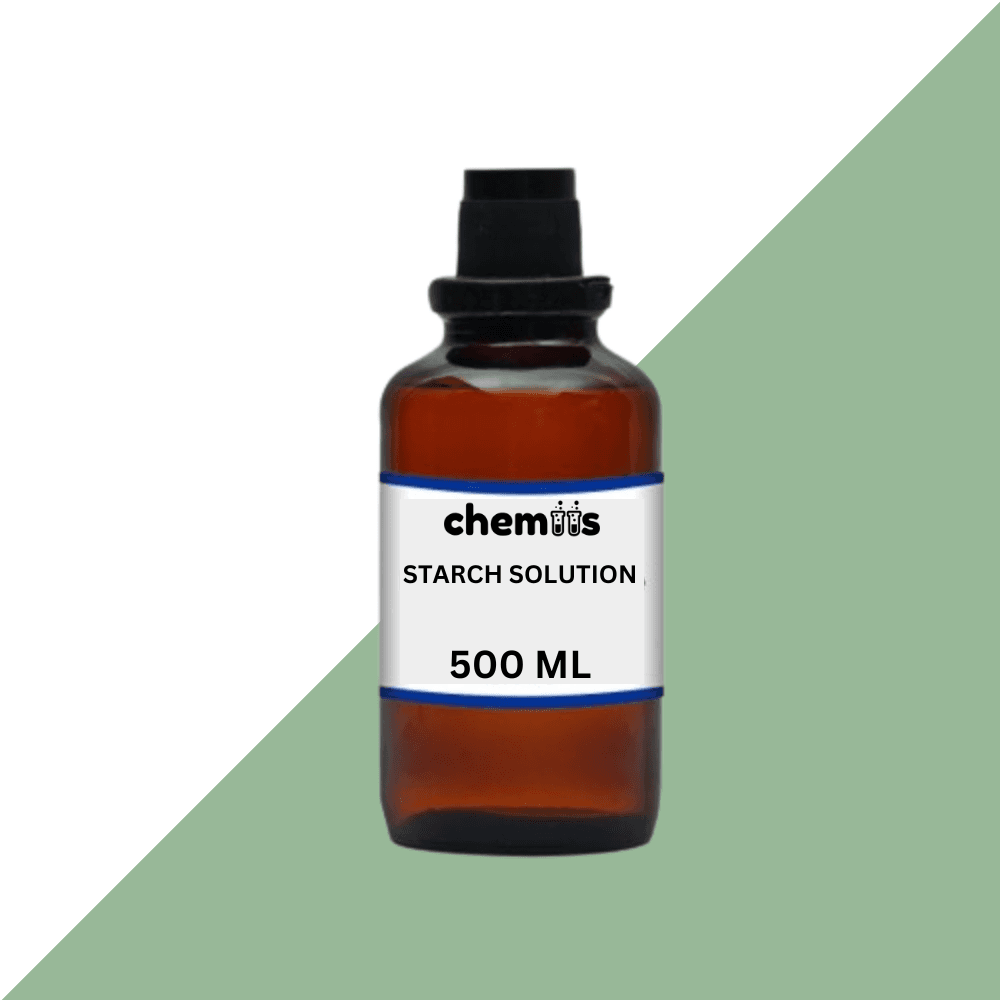Starch Solution is a mixture of starch dissolved in water, commonly used in various industries due to its thickening, gelling, and stabilizing properties. Starch solution is typically prepared by heating starch in water, allowing the starch granules to swell and dissolve, forming a gel-like consistency. The starch solution is used in a wide range of applications, from food products to pharmaceuticals and industrial processes. It is highly valued for its versatility, natural origin, and ability to modify the texture and viscosity of different formulations.
Applications:
1. Food Industry:
- Thickening Agent: Starch solution is widely used as a thickening agent in food products like sauces, soups, gravies, and dressings. It provides smooth texture and consistency without altering the flavor of the product.
- Confectionery: In candies and jellies, starch solutions help provide the required texture and mouthfeel. It is often used in sugar syrups to prevent crystallization and ensure a smooth product.
- Dairy Products: Starch solution is used in dairy-based products like puddings, ice cream, and custards to give them a creamy, stable consistency and to improve shelf life.
- Baking: It is used in baked goods like cakes, cookies, and gluten-free products to improve moisture retention, texture, and shelf stability.
2. Pharmaceutical Industry:
- Suspension Formulations: Starch solution is used in the preparation of liquid suspensions and syrups. It helps to evenly distribute active pharmaceutical ingredients and prevent sedimentation, ensuring consistent dosage and efficacy.
- Tablet Coatings: It is used in the formulation of tablet coatings, acting as a binder and helping the tablet break apart at the correct time during digestion.
- Wound Dressings: Starch solution is sometimes incorporated into wound care products, providing moisture retention and promoting a suitable environment for healing.
3. Cosmetic and Personal Care:
- Hair Care: In dry shampoos, starch solution is used as an absorbent to remove excess oil from the scalp and refresh hair without washing.
- Skin Care: It is used in lotions, creams, and masks for its soothing and thickening properties. It helps to give the products a smooth, silky texture and is often used in formulations for sensitive skin.
- Makeup: Starch solution is used in face powders, foundations, and other cosmetic products to enhance texture, improve spreadability, and provide a mattifying effect.
4. Industrial Applications:
- Textile Industry: Starch solution is used in the textile industry for sizing fabrics. It helps to add strength, smoothness, and durability to fabrics during processing, making them easier to weave and finish.
- Paper and Packaging: In the paper industry, starch solution is used as a binding and coating agent to improve paper strength, print quality, and surface finish.
- Adhesives: Starch solution is a key ingredient in manufacturing adhesives used in the paper, packaging, and textile industries. It helps create a strong and durable bond between materials.
5. Printing and Packaging:
- Packaging: Starch solution is used in the production of biodegradable packaging materials, where it acts as a binder for molded pulp products, making them strong and lightweight while being environmentally friendly.
- Printing Inks: It is used in the formulation of printing inks to provide the desired texture and viscosity, making the ink easier to apply to various surfaces.
Safety Guidelines:
- Personal Protective Equipment (PPE):
- Skin Protection: Starch solution is generally safe for skin contact. However, prolonged exposure in an industrial setting may cause skin irritation. Wearing gloves and protective clothing is recommended when handling large amounts of starch solution.
- Eye Protection: If handling in bulk or in the form of a spray, safety goggles or face shields should be worn to avoid irritation in case of splashes.
- Respiratory Protection: In environments where starch solution is used in powdered or aerosolized form (such as in the preparation of starch pastes or sprays), a dust mask or respirator should be worn to avoid inhaling airborne starch particles.
- Storage:
- Store starch solution in tightly sealed containers in a cool, dry place, away from direct sunlight and moisture to maintain its stability and consistency.
- Avoid exposing starch solution to high temperatures for prolonged periods, as this may cause it to degrade or lose its thickening properties.
- First Aid:
- Inhalation: If excessive exposure to starch dust or vapor occurs, move the affected person to fresh air immediately. Seek medical attention if symptoms persist.
- Skin Contact: In case of skin irritation, wash the affected area thoroughly with soap and water. If irritation continues, seek medical advice.
- Eye Contact: If the starch solution comes into contact with eyes, rinse immediately with plenty of water for at least 15 minutes. Seek medical attention if irritation persists.
- Ingestion: Although generally considered safe for consumption in food products, if large amounts are ingested, seek medical advice.
- Disposal:
- Dispose of starch solution according to local regulations. Small quantities can usually be disposed of as normal waste, while larger amounts should be disposed of in an environmentally responsible manner to prevent contamination of water sources.


















Reviews
Clear filtersThere are no reviews yet.